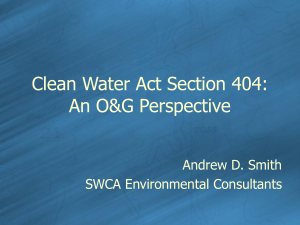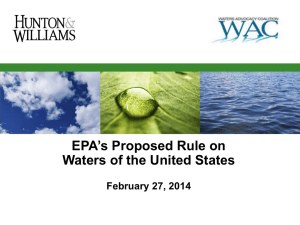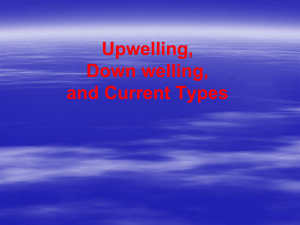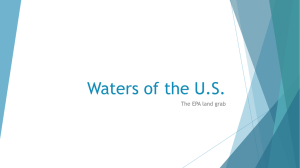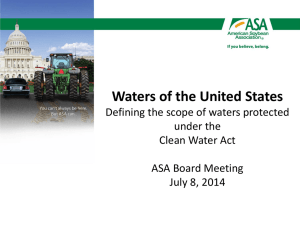traditional navigable waters
advertisement
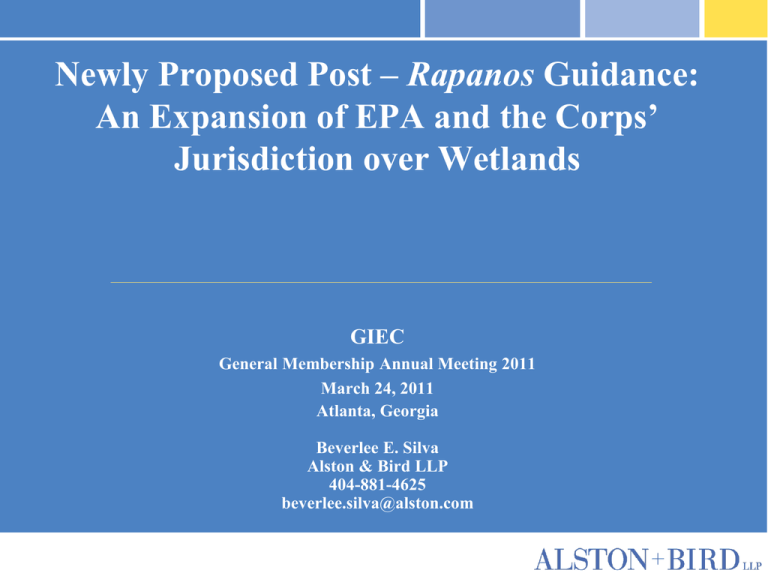
Newly Proposed Post – Rapanos Guidance: An Expansion of EPA and the Corps’ Jurisdiction over Wetlands GIEC General Membership Annual Meeting 2011 March 24, 2011 Atlanta, Georgia Beverlee E. Silva Alston & Bird LLP 404-881-4625 beverlee.silva@alston.com Rapanos v. United States 547 U.S. 715 (2006)* *Revisited, yet again Is it a “Water of the United States” Rapanos sought to determine the scope of Clean Water Act’s jurisdiction: Regulates “Navigable Waters” “navigable waters” are “waters of the United States, including the territorial seas . . .” 33 U.S.C. § 1362(7) What is a “water of the United States?” The Disharmonious Supremes Scalia (4) – Plurality opinion Kennedy (1) – Significant Nexus opinion Stevens (4) – Dissenting opinion Plurality Decision (Scalia) Corps’ expansive “land is waters” approach goes beyond CWA Waters are ONLY those relatively permanent, standing or continuously flowing bodies of water forming geographic features that are described in ordinary parlance as streams, oceans, rivers, and lakes. Waters are NOT channels through which water flows intermittently or ephemerally or channels that periodically provide drainage for rainfall. Scalia Two-Part Test 1. (Adjacent) Relatively permanent body of water connected to traditional interstate navigable water, and 2. (Connected) Continuous surface connection with that water, making it difficult to determine where the water ends and the wetland begins. Kennedy Opinion Requires significant nexus between the wetlands and navigable waters (traditional) Significant nexus is met if the wetlands, either alone or in combination with similarly situated lands in the region, significantly affect the chemistry, physical and biological integrity of navigable waters Adjacent wetlands meet the test, but otherwise case-by-case determination EPA/Corp Attempt to Interpret EPA and the Army Corps of Engineers have made two attempts to issue “guidance” about what the Rapanos decision means in practice. Issued Post-Rapanos guidance on June 5, 2007 and December 3, 2008 2007 Guidance was not much help because it failed to adequately define “significant nexus.” 2008 Guidance is currently in effect. Existing Guidance How does it categorize “waters of the United States?” Definitely Jurisdictional The agencies will assert jurisdiction over the following waters: Traditional navigable waters Wetlands adjacent to traditional navigable waters Non-navigable tributaries of traditional navigable waters that are relatively permanent where the tributaries typically flow year-round or have continuous flow at least seasonally (e.g., typically three months) Wetlands that directly abut such tributaries Maybe Jurisdictional The agencies will decide jurisdiction over the following waters based on a factspecific analysis to determine whether they have a significant nexus with a traditional navigable water: Non-navigable tributaries that are not relatively permanent Wetlands adjacent to non-navigable tributaries that are not relatively permanent Wetlands adjacent to but that do not directly abut a relatively permanent nonnavigable tributary Not Jurisdictional The agencies will generally not assert jurisdiction over the following features: Swales or erosional features (e.g., gullies, small washes characterized by low volume, infrequent, or short duration flow Ditches (including roadside ditches) excavated wholly in and draining only uplands and that do not carry a relatively permanent flow of water The agencies will apply the significant nexus standard as follows: A significant nexus analysis will assess the flow characteristics and functions of the tributary itself and the functions performed by all wetlands adjacent to the tributary to determine if they significantly affect the chemical, physical and biological integrity of downstream traditional navigable waters. Significant nexus includes consideration of hydrologic and ecologic factors. How Has the Existing Guidance Been Received? Not popular with anybody Democrats in Congress proposed new legislation to significantly increase definition of jurisdictional waters, but it went nowhere Administration decided to try again 2010 Draft Guidance Attempt # 3 Status of New Guidance The draft 2010 Guidance was sent in February 2011, to the White House Office of Management and Budget (OMB) for review and has not yet been officially released. Under Executive Order 12866, OMB has up to 90 days to review the Guidance and suggest changes. EPA and the Corps have said they will provide an opportunity for public comment, although it will not be the full notice and comment rulemaking afforded agency regulations under the Administrative Procedures Act (“APA”). What is the Expected Impact? The proposed guidance is a significant departure from the Existing Guidance and relies more explicitly on the view taken by Justice Kennedy in the Supreme Court’s Rapanos decision Many in industry are interpreting it to significantly expand federal jurisdiction under the Clean Water Act over millions of acres of property. What’s New? “This guidance reflects the relevant science and responds to the agencies’ experience implementing previous guidance documents.” “. . . alleviates the need to develop extensive administrative records for certain jurisdictional determinations that caused delays and added costs to both federal agencies and the regulated community.” The draft guidance seeks to address limits on the water law’s scope by offering a new interpretation of the test provided by Kennedy, while reiterating EPA’s litigation position that regulators can rely on either the Kennedy test or the Scalia test when determining jurisdiction. Why? “The 2008 Rapanos guidance [Attempt #2] reflected a policy choice to interpret Justice Kennedy’s opinion narrowly, resulting in fewer waterbodies found to be jurisdictional under the CWA than under a more faithful interpretation.” The 2010 Guidance purports to refine the agencies’ interpretation of the “significant nexus” standard so it is consistent with Kennedy’s opinion and “the science of aquatic ecosystems.” Also purports to determine the jurisdictional status of waters not addressed by earlier guidance (for example, interstate waters). Still Guidance Not Regulation Attempt #3 is still just guidance. It does not have a legally binding effect on EPA, the Corps, or the regulated community. “. . . Interested persons are free to raise questions regarding the application of this guidance to a particular situation. . . .” NEW REGULATIONS WILL BE PROPOSED FOR 2011 CONSISTENT WITH THE NEW GUIDANCE So what’s in the Draft 2010 Guidance? SUMMARY OF KEY POINTS Jurisdictional Waters The Agencies will assert jurisdiction over: Traditional Navigable Waters Interstate Waters Wetlands adjacent to either traditional navigable waters or interstate waters Non-navigable tributaries to traditional navigable waters that are relatively permanent, meaning at least seasonal Wetlands that directly abut relatively permanent waters Maybe Jurisdictional The following waters are subject to CWA jurisdiction if a fact-specific analysis determines they have a “significant nexus” to a traditional navigable water or interstate waters: Tributaries to traditional navigable waters or interstate waters Wetlands adjacent to jurisdictional tributaries to traditional navigable waters or interstate waters Waters that fall under the “other waters” category of the regulations. Not Jurisdictional The following aquatic areas are generally not subject to Clean Water Act jurisdiction as waters of the United States: Wet areas that are not tributaries or open waters or do not meet the agencies’ regulatory definition of “wetlands” Waters excluded from coverage under the CWA by existing regulations Waters that lack a “significiant nexus” where one is required for a water to be subject to CWA jurisdiction Also Not Jurisdictional Artificially irrigated areas that would revert to upland should irrigation cease Artificial lakes or ponds created by excavating and/or diking dry land and used exclusively for such purposes as stock watering, irrigation, settling basins, or rice growing Artificial reflecting pools or swimming pools created by excavating and/or diking dry land Also Not Jurisdictional Small ornamental waters created by excavating and/or diking dry land for primarily aesthetic reasons Water-filled depressions created incidental to construction activity 2011 Draft Guidance is Very Robust Divided into Eight Separate Sections The first two sections address the fundamental classes of waters subject to Clean Water Act jurisdiction: traditional navigable waters and interstate waters. Section 3 provides general guidance relating to Kennedy’s “significant nexus” standard The next three sections provide guidance on determining whether various types of waters are subject to CWA jurisdiction, including: Tributaries (Section 4); Adjacent wetlands (Section 5); and Other waters (Section 6) Section 7 discusses examples of waters over which the CWA has no jurisdiction Section 8 provides guidance on the documentation necessary to jurisdictional decisions Significant Nexus: An Expansive, New 4 Page Explanation “Waters have the requisite nexus if they, either alone, or in combination with similarly situated waters in the region, significantly affect the chemical, physical, or biological integrity of traditional navigable waters or interstate waters.” What will the Agencies Look at? Significant Nexus Determination Are the waters “similarly situated” with other waters of the same regulatory or resource type? Are they in the same watershed, “defined by the area draining into the nearest traditional navigable water or interstate water” If so, there is a significant nexus “if they alone or in combination” they would have an effect on the chemical, physical, or biological integrity of traditional navigable waters or interstate waters that is more than ‘speculative or insubstantial” Hydrologic Connection Not Necessary The draft guidance also notes that a “hydrologic connection” is not necessary to determine jurisdiction under Kennedy’s test because: “in some cases the lack of hydrologic connection would be a sign of the water’s function in relationship to the traditional navigable or jurisdictional water, such as retention of flood waters or pollutants that would otherwise flow downstream to the traditional navigable or interstate water” Expansion of Jurisdictional Wetlands Has the potential to assert jurisdiction over wetlands away from traditional navigable waters, based on the impacts of proposed activity in those wetlands “ . . . while it may be difficult to demonstrate that a particular individual wetland adjacent to a small headwater tributary has a significant nexus to a traditional navigable water, the destruction of all such adjacent wetlands in a region could have significant effect on the traditional navigable water and, thus, in such circumstances the CWA must protect those wetlands in order to protect the traditional navgiable water,” “The same logic applies to tributaries and similarly situated other waters.” Expected Results in the Field “The Agencies expect that the number of waters found to be subject to CWA jurisdiction will increase significantly compared to practices under [past] guidance.” The “scope of waters subject to CWA jurisdiction will still not be as extensive as it was prior” to the Supreme Court’s action. Political Fallout Even though the 2010 Guidance has not yet been released, it is unpopular in several camps. Already has stiff opposition from industry groups. House Republicans have also included language in their spending plan for the remainder of fiscal year 2011 that blocks EPA from issuing the guidance. Separate from their attempt to de-fund EPA. The disagreements will no doubt escalate if the agencies issue regulations this year as promised.

